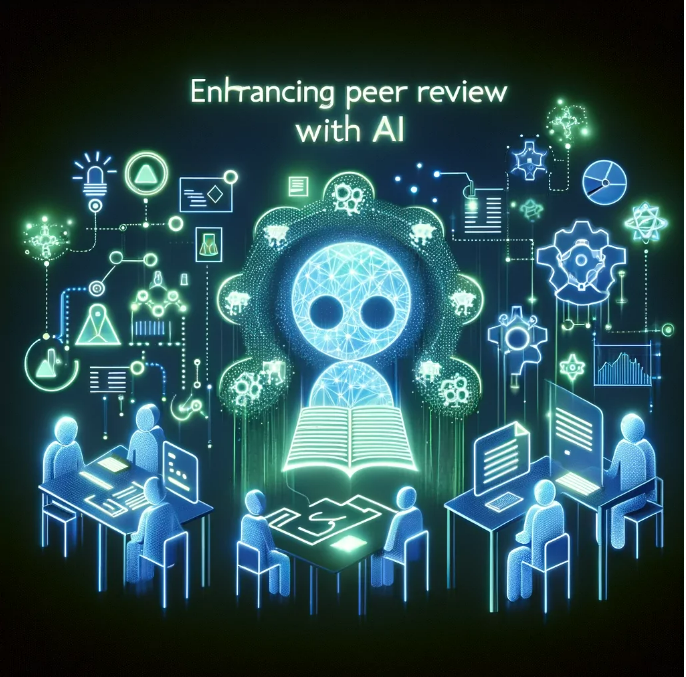In an era where the proliferation of digital technology dictates progress across various sectors, the term ‘Artificial Intelligence’ (AI) has become a cornerstone of innovation. This article aims to explore the Benefits of AI in Publishing, focusing on how AI’s integration into the field signifies a shift towards more efficient, intelligent, and data-driven decision-making processes, transforming operations, enhancing quality, and increasing efficiency.
Definition of AI and its relevance in the modern world
Artificial Intelligence (AI) encompasses the creation of systems that can perform tasks typically requiring human intelligence. These tasks include learning from experiences, understanding complex data, responding to changes, and making decisions with a semblance of human judgment. AI’s relevance in today’s world is manifold; it drives cars, powers virtual assistants, secures transactions, and even recommends the next series to binge-watch. Its omnipresence and versatility make it one of the most revolutionary and rapidly evolving technologies of our time, impacting economies, industries, and day-to-day activities.
Brief history of AI in publishing
The history of AI in publishing traces back several decades when it first emerged as a tool for automating basic tasks such as spell checking and typographic layout designs. Over the years, the technology evolved, and its footprint in publishing expanded. By the 1990s and early 2000s, AI began to revolutionize publishing by enabling more sophisticated applications like content management systems that could handle large volumes of data and assist in organizing and distributing digital content.
With the advent of machine learning and natural language processing, AI’s role evolved further, enabling more nuanced tasks such as targeted content recommendation, reader behavior prediction, and even content creation. This gradual integration has set the stage for a new era in publishing, where AI is a key player in driving innovation and efficiency.
Start Your Publishing Journey FOR FREEImportance of AI in enhancing publishing efficiency and quality
AI’s prominence in the publishing industry cannot be understated when considering efficiency and quality. It has the power to automate and optimize tasks that once consumed considerable time and resources, such as sorting submissions, proofreading, and market analysis. This increase in efficiency is not at the cost of quality; on the contrary, AI tools help maintain, if not improve, the quality of content by providing advanced editing tools and ensuring consistency and accuracy.
The technology’s ability to analyze data at scale also offers publishers unparalleled insights into reader preferences, market trends, and content performance. By enabling these efficiencies and quality improvements, AI has become indispensable for publishers aiming to thrive in a competitive and ever-evolving digital marketplace. This foundational role of AI serves as the linchpin of our exploration into its extensive benefits within the publishing ecosystem.

AI Tools in Publishing
The arsenal of AI tools has burgeoned within the publishing industry, leading to profound enhancements in how content is managed, distributed, marketed, and consumed. These tools, harnessing the power of AI, are not only reshaping the back-end processes but also elevating the user experience and engagement with published content.
Content Management Systems with AI capabilities
Modern content management systems (CMS) have evolved to become much more than simple platforms for storing and organizing content; they are now intelligent systems equipped with AI capabilities, leading to significant advances in the handling of published materials.
- Automated content categorization: The inundation of digital content necessitates a system that can automatically sort and categorize vast amounts of data. AI excels in this area by analyzing content and classifying it into predefined categories. This not only saves time but also enhances discoverability and retrievability. For instance, an article about AI in healthcare can be tagged under both ‘Technology’ and ‘Health’ without human intervention, ensuring it reaches a broader, more relevant audience.
- Metadata tagging and indexing: Metadata tagging and indexing are crucial for the accessibility and visibility of content. AI enhances these aspects by automatically tagging content with relevant metadata, which in turn supports improved search engine optimization (SEO) and discoverability. The indexing process, too, is expedited by AI, allowing for quicker and more accurate retrieval of information, which is invaluable for both publishers and users searching for relevant data and articles.
AI in Distribution and Marketing
Distribution and marketing in the digital publishing world have been particularly transformed by AI, allowing for sophisticated and nuanced approaches that were previously not possible.
- Personalized content recommendations: AI algorithms analyze user behavior, preferences, and reading patterns to suggest personalized content recommendations. This not only enhances user engagement by providing readers with what they are more likely to enjoy but also increases the chances of content consumption. Platforms like Amazon and Google use such AI tools to enhance user experience and increase sales through accurate recommendations.
- Targeted marketing campaigns: Targeted marketing campaigns are more effective thanks to AI’s ability to analyze large datasets and identify patterns. Publishers can now create marketing campaigns that are tailored to the interests and behaviors of their audience segments. AI tools can predict which users are most likely to engage with certain types of content or promotional offers, thereby increasing conversion rates and ROI on marketing efforts.
Interactive and Multimedia E-books
The realm of e-books has seen a remarkable transformation with the integration of AI, making reading an interactive and inclusive experience.
- Enhanced reader engagement: AI has enabled the creation of interactive e-books with multimedia features, which respond to the readers’ input and learn from their interactions. This not only makes the reading experience more engaging but also helps to maintain the reader’s interest for longer periods. Enhanced engagement through multimedia content and interactive elements has opened new avenues for publishers to explore storytelling.
- Accessibility features: AI-driven e-books now come with advanced accessibility features like text-to-speech, automatic translation, and responsive design that adapts to different devices and screen sizes. These features make content more accessible to people with disabilities or non-native language speakers, thus broadening the potential audience for publishers.
AI-driven Analytics for Publishers
Data is at the heart of modern publishing, and AI has revolutionized how this data is analyzed and interpreted.
- Predictive analysis for trends and sales: Publishers are now using AI-driven analytics to not only understand current trends but also to predict future ones. Machine learning algorithms can sift through past sales data, reviews, and reading habits to forecast future sales and identify potential hits before they become mainstream. This predictive power enables publishers to make more informed decisions about which books to invest in.
- Reader behavior and preferences: AI tools go beyond just tracking which books sell; they can analyze reader behavior in-depth, such as which sections of an e-book are most read and which are skipped, how reading habits vary by demographic, and what kind of content hooks readers the most. This treasure trove of data can be used to tailor future content to reader preferences, leading to higher satisfaction and loyalty.
The employment of AI tools in publishing has thus paved the way for more sophisticated content management, targeted distribution, engaging multimedia e-books, and insightful analytics, all of which contribute to a more dynamic and responsive publishing landscape.

Natural Language Processing (NLP) in Publishing
Natural Language Processing (NLP), a subset of AI, concerns itself with the interaction between computers and human language. In the context of publishing, NLP has emerged as a groundbreaking technology with versatile applications that streamline the editing process, open new markets, and assist in content creation.
Understanding NLP and its applications in publishing
NLP enables machines to understand, interpret, and generate human language in a way that is both meaningful and useful. In publishing, NLP applications range from improving the quality of written content to providing insights into reader preferences. Its ability to process and analyze large volumes of text rapidly makes it a powerful tool for the industry.
AI-powered proofreading and editing tools
AI-infused proofreading and editing tools are transforming the writing process by automating some of the most time-consuming aspects of preparing a manuscript for publication.
- Grammar and style enhancements: These tools go beyond traditional spellcheckers to offer sophisticated grammar corrections and style suggestions that can adapt to various writing styles and genre-specific conventions. They help writers enhance the readability and clarity of their work while maintaining their unique voice.
- Consistency and fact-checking features: NLP-powered tools can also ensure consistency in terminology and factual accuracy across a manuscript. For example, they can detect when a character’s name is misspelled or identify discrepancies in the narrative timeline, helping authors and editors maintain continuity in their storytelling.
Automated translation and localization
NLP has significantly advanced the capabilities of translation software, making books and other written materials more accessible to a global audience.
- Expanding global reach: Automated translation tools powered by NLP allow publishers to rapidly and cost-effectively localize content for different regions, vastly expanding their potential market. While human translators remain essential for nuanced literary work, NLP can handle straightforward texts or provide a solid first draft for human refinement.
- Overcoming language barrier: NLP facilitates real-time translation services, breaking down language barriers that once restricted the flow of information. Readers around the world can now access a variety of content in their native languages, which is particularly transformative for academic and educational publishing.
Text generation and summarization
One of the more advanced applications of NLP is in text generation and summarization, which can support authors and publishers in several ways.
- Creating drafts and book summaries: NLP algorithms can generate coherent and contextually relevant text based on input parameters, which can aid authors in drafting chapters or creating book summaries. These summaries can be particularly useful for marketing purposes or for providing readers with quick insights into the content.
- Support for author creativity: Far from replacing human creativity, NLP tools can stimulate it by suggesting new ideas, plot developments, or even dialogue options based on the existing text. This can help authors overcome writer’s block and enrich their narratives, ultimately contributing to more compelling and diverse literature.
In essence, NLP serves as a bridge between human expertise and machine efficiency in the publishing industry. It empowers publishers and writers with tools for better writing, offers solutions for multi-language publishing, and encourages creative endeavors through advanced text manipulation capabilities.

Machine Learning (ML) in Publishing
Machine Learning (ML), a core component of artificial intelligence, involves the development of algorithms that enable computers to learn from and make predictions or decisions based on data. Its introduction into the publishing industry is reshaping traditional practices, offering predictive insights, and customizing reader experiences.
The Basics of ML and Its Significance in Publishing
Machine Learning algorithms analyze historical data to detect patterns and predict future trends. In publishing, ML can process vast amounts of data from sales, reader behavior, and online engagement to inform decision-making. By predicting trends and reader preferences, ML allows publishers to be more proactive, crafting strategies that align closely with market dynamics.
Predictive Algorithms for Audience Growth
ML’s ability to predict trends is particularly useful in understanding and expanding a publisher’s audience.
- Reading Pattern Analysis: ML algorithms can examine readers’ behavior, such as which books they purchase, which pages they linger on, and what reviews they leave. By identifying common reading patterns, publishers can tailor their marketing efforts and editorial decisions to the preferences of their audience, thereby fostering reader loyalty and expanding their reach.
- Subscription Modeling: Subscription services can benefit from ML by analyzing subscriber data to predict churn rates and identify the key factors that keep users engaged. This insight allows publishers to adjust their subscription models in real time, offering personalized experiences that are more likely to convert one-time readers into long-term subscribers.
Machine Learning in Content Curation
Content curation powered by ML personalizes the reader experience by suggesting titles likely to interest them, enhancing discovery and satisfaction.
- Customized Reading Lists: By analyzing individual reading habits and comparing them with broader trends, ML can generate customized reading lists for users, thus simplifying the discovery process for readers and connecting them with books they are more likely to enjoy and purchase.
- Dynamic Content Adjustment: For digital publishing platforms, ML can help in dynamically adjusting content based on user feedback and engagement. If certain chapters or sections are routinely skipped or negatively reviewed, algorithms can suggest that publishers revise or even remove such content in future editions.
ML in Rights Management and Pricing Strategy
The applications of ML extend into the intricate areas of rights management and pricing strategies, making these complex processes more efficient.
- Smart Contract Management: ML can assist in managing the vast array of contracts associated with publishing rights by analyzing contract terms, usage, and licensing patterns to help publishers optimize their rights portfolios and avoid legal pitfalls.
- Dynamic Pricing Models: Dynamic pricing, where the price of a book fluctuates based on demand, competition, and other factors, can be effectively managed with ML. Algorithms can monitor market conditions and adjust prices in real time to maximize revenue while remaining competitive, ensuring that publishers can respond swiftly to market shifts.
Machine Learning is thus carving out a niche as an indispensable tool in the publishing industry, offering solutions that streamline operations, enhance user engagement, and increase the bottom line. It serves as the analytical engine driving a more adaptive, personalized, and strategic approach to the challenges of modern publishing.

Enhancing Peer Review with AI
The peer review process is a cornerstone of scholarly publishing, ensuring the credibility and quality of academic papers. However, traditional methods face challenges that can be addressed by the integration of artificial intelligence (AI).
Challenges in Traditional Peer Review Processes
Traditional peer review processes often grapple with issues such as prolonged review times, potential bias, difficulty in finding appropriate reviewers, and inconsistencies in review quality. Human reviewers, despite their expertise, can overlook errors or fall prey to subconscious biases. Additionally, the increasing volume of submissions to academic journals has made the review process more burdensome and time-consuming.
Start Your Publishing Journey FOR FREEAI Applications in Manuscript Screening
AI tools are now being developed to augment the initial stages of the peer review process, enhancing efficiency and accuracy.
- Preliminary Quality Checks: AI can conduct initial quality control checks for submissions, ensuring that manuscripts meet the basic formatting and submission guidelines of the journal. This not only saves time for journal editors but also streamlines the process for authors by providing immediate feedback.
- Plagiarism Detection: Plagiarism is a serious concern in scholarly publishing. AI-assisted peer review can include sophisticated plagiarism detection tools that can scan texts for copied content more efficiently than human reviewers. These systems can check databases and published work across numerous languages and fields, ensuring the originality of the submitted manuscripts.
AI Support in Matching Reviewers
Finding and managing peer reviewers is a complex task that AI is well-equipped to handle.
- Finding Subject Matter Experts: AI algorithms can analyze the content of a manuscript and suggest potential reviewers based on their published work, expertise, and previous review history. This helps in identifying the most qualified human researchers to evaluate the work.
- Managing Reviewer Workloads: AI systems can track the number of reviews a potential reviewer is currently handling or has completed in the past, helping to balance workloads and prevent reviewer fatigue. This ensures that reviewers can dedicate appropriate attention to each manuscript.
Improving the Quality and Speed of Peer Review
AI can enhance the depth and speed of the peer review process in several ways.
- Anomaly Detection in Data: Machine learning algorithms are capable of identifying anomalies in data that may indicate errors or potential misconduct. AI can flag statistical inconsistencies or results that deviate significantly from known patterns, prompting a more thorough review.
- Bias Detection and Mitigation: AI can help in identifying and mitigating bias by analyzing the peer review process and the language used within reviews. It can highlight instances where a reviewer’s feedback may be influenced by factors unrelated to the content of the manuscript. Additionally, AI can assist editors in making balanced editorial decisions by providing data-driven insights into the review process.
By integrating AI tools into peer review, publishing companies can address many of the existing challenges, enhancing the quality, integrity, and efficiency of scholarly publishing. These advancements not only save time but also contribute to the robustness of academic discourse, ensuring that research is disseminated based on its merit and relevance to the field.

Benefits of AI in Publishing – Conclusion
AI has proven its value across various facets of the publishing industry, demonstrating that when used effectively, it can significantly enhance operational efficiency, content quality, and user engagement. With AI tools, tasks like content categorization, metadata tagging, and personalized distribution become more streamlined and precise. Natural Language Processing (NLP) has fine-tuned the writing process, offering sophisticated editing and proofreading, while overcoming language barriers through automated translation services. Furthermore, machine learning algorithms have opened up new vistas in understanding and predicting reader behavior, aiding publishers in crafting strategies that resonate with shifting consumer patterns.
Embracing AI is not merely a matter of keeping pace with technological advancements—it’s about securing a competitive edge in a rapidly evolving industry. Publishers and authors who leverage AI tools can expect to see not only an enhancement in productivity but also in the richness and reach of their content. AI-generated content, while still requiring the nuanced touch of human creativity, offers a new realm of possibilities for augmenting human writing, generating new ideas, and expanding the narrative capabilities of authors.







